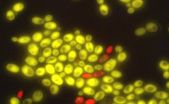(Press-News.org) For centuries, humans have been playing with yeast. But these simple fungal cells usually do their jobs -- making bread rise or converting sugar into alcohol -- without having to communicate or work together.
Now, a team of University of Washington researchers has engineered yeast cells (Saccharomyces cerevisiae) that can "talk" to one another, using a versatile plant hormone called auxin.
In a paper published June 23 in the American Chemical Society's journal ACS Synthetic Biology, the researchers describe a novel cell-to-cell communication system that enables one yeast cell to regulate the expression of genes and influence the behavior of an entirely separate yeast cell.
It's a basic step in understanding the communication and cooperative processes that might lead to synthetic stem cells that could grow into artificial organs or organisms that require different types of cells to work together.
"Until you can actually build a multicellular organism that starts from a single cell, you don't really understand it. And until we can do that, it's going to be hard to do things like regrow a kidney for someone who needs it," said senior author Eric Klavins, a UW associate professor of electrical engineering and of bioengineering.
It might also enable engineered yeast to perform complicated behaviors that coordinated multicellular systems such as our immune system can pull off, like recognizing an invading pathogen and mounting a response. If so, one might program those cells to collaboratively diagnose the flu or malaria: just add saliva to a packet of yeast and see if it changes color.
For now, though, the team spearheaded by lead authors Arjun Khakhar, a UW doctoral student in bioengineering, and Nicholas J. Bolten, a UW doctoral student in electrical engineering, simply wanted to see if it could induce one yeast cell to send a signal that sets off a cascade of changes in another cell.
In the initial experiment, they used the plant hormone auxin -- which yeast cells don't normally recognize or respond to -- to "turn off" a target gene in another cell. In this case, the gene that was switched off was an inserted jellyfish gene that turned the yeast fluorescent green.
"This project was to find out whether we could use auxin to make the cells talk to each other in a really simple way," said Klavins. "We're not sending complicated messages yet. One cell is saying 'hello?' and the other cell says 'I can hear you.' Eventually they'll say 'I'm this kind of cell. What are you? Let's work together.' But for now it's pretty much 'hi.'"
Synthetic biologists, who assemble genetic parts in new ways with the goal of popping them into an organism to produce reliable behaviors, have struggled to build modules that enable cell-to-cell communication in organisms that don't naturally do it.
The UW team overcame this hurdle by engineering a suite of novel transcription factors -- proteins that control whether a specific gene inside a cell's DNA is expressed or not -- with varying sensitivities to auxin. That "tunability" offers important control in regulating cell behavior.
With co-author and UW associate biology professor Jennifer Nemhauser, the UW team figured out how to make a "sender" yeast cell produce auxin, a versatile hormone that controls everything from where a plant's roots develop to how effectively they fight off pathogens. Through trial and error, the team learned an enzyme borrowed from a soil bacterium can induce yeast to convert a commonly available chemical into auxin.
In the "receiver" yeast cells, the researchers inserted the new transcription factor -- which was assembled from so many different genetic parts that they call it the "Frankenfactor" - and engineered it to activate the jellyfish gene that turned the cell green.
When the sender cell released auxin, additional proteins that the researchers introduced in the receiver cell were able to degrade the Frankenfactor and switch off the gene that turned the receiver cell green.
That type of simple communication forms the bedrock of multicellular organisms in which different types of cells collaborate to carry out complicated tasks. As a next step, the UW team plans to test whether auxin can induce more complex behaviors in yeast cells, such as forming patterns or cooperatively computing basic functions.
Since auxin is a plant hormone, mammalian cells also ignore it, making auxin a potentially useful tool in designing gene therapies or other applications without adverse reactions in humans. The UW method, which uses a "guide RNA" to target the gene of interest, could be adapted to produce a number of genetic or behavior changes.
"If you ask someone in computer science what they can do with a programming language, they'll laugh and say they can do anything with it," Klavins said. "If we can figure out the programming language of life, we can do anything that life does -- except in a more controllable, reliable way."
INFORMATION:
The research was funded by the National Science Foundation and the Paul Allen Family Foundation.
For more information, contact Klavins at klavins@u.washington.edu.
NSF grant numbers: 1411949, 1137266 (EFRI-MKS), 1317653
People on a vegetarian diet, and especially those following a vegan one that includes no animal products, see better results than dieters on other weight-reducing plans. In fact, they can lose around two kilograms more on the short term, says Ru-Yi Huang of E-Da Hospital in Taiwan after reviewing the results of twelve diet trials. The findings¹ appear in the Journal of General Internal Medicine², published by Springer.
Huang's review includes twelve randomized controlled trials, involving 1,151 dieters who followed a specific eating regime for between nine ...
German researchers found osteopathic manipulative therapy (OMTh) decreased postpartum low back pain by over 70 percent in women who had given birth at least three months before beginning treatment, according to a new study published in July issue of the Journal of the American Osteopathic Association.
The eight week study, devised as a pragmatic randomized controlled trial, surveyed 80 women experiencing low back pain three to 15 months postpartum. Women in the study group received four OMTh treatments at two week intervals. Participants in the control group did not ...
LA JOLLA-- Mice that have a genetic version of mitochondrial disease can easily be mistaken for much older animals by the time they are nine months old: they have thinning grey hair, osteoporosis, poor hearing, infertility, heart problems and have lost weight. Despite having this disease at birth, these mice have a "secret weapon" in their youth that staves off signs of aging for a time.
New research from the Salk Institute reveals how a longevity hormone helps these mice--born with thousands of mutations in their energy-generating mitochondria--maintain metabolic homeostasis ...
Forest composition, ground cover and topography are the best predictors of forest fire severity in the Western U.S., according to Penn State physical geographers who also see that the long history of fire exclusion on federal lands leads to uncharacteristically severe burns and potentially changes the dynamics of forests and their recovery.
A hunter's illegal campfire in Stanislaus National Forest adjacent to Yosemite National Park started what would become the Rim fire, the third largest fire in California history, that burned from August through October 2013. The fire ...
WEST LAFAYETTE, Ind. - Researchers who developed a high-speed form of atomic force microscopy have shown how to image the physical properties of live breast cancer cells, for the first time revealing details about how deactivation of a key protein may lead to metastasis.
The new findings also are providing evidence for the mechanisms involved in a cell's response to anti-cancer drugs, said Arvind Raman, Purdue University's Robert V. Adams Professor of Mechanical Engineering.
In atomic force microscopy (AFM), a tiny vibrating probe called a cantilever passes over a material, ...
This news release is available in French. Montreal, June 30, 2015 -- Unsafe drinking water is a topic usually connected to the developing world. But the regular recurrence of boil-water advisories, and widely publicised outbreaks in towns like Walkerton and Kashechewan have shown that, even in Canada, clean water cannot be taken for granted.
The increased scrutiny that arose from such issues has resulted in widespread criticism of the uneven drinking water regulation among Canada's provinces and territories.. However, centralizing water regulation is not necessarily ...
The Southern Pacific Ocean Tropical Cyclone Season just got an extension with the birth of a new tropical depression near the Solomon Islands. NASA's Aqua satellite passed over the new depression and saw that it was already affecting some of the islands.
The Solomon Islands make up a nation that consists of hundreds of islands in the South Pacific.
The MODIS or Moderate Resolution Imaging Spectroradiometer instrument aboard NASA's Aqua satellite captured a visible image of Tropical Depression 25P as it was forming in the Southern Pacific, just north of the Solomon ...
NASA-NOAA's Suomi NPP Satellite passed over the newborn ninth tropical depression of the Northwestern Pacific Ocean typhoon season on June 30.
At 02:55 UTC (10:55 p.m. EDT, June 29), the VIIRS or Visible Infrared Imaging Radiometer Suite (VIIRS) instrument aboard NASA-NOAA's Suomi satellite captured a visible image of the newly developed depression. The VIIRS image revealed bands of thunderstorms wrapping into the low-level center from the north and western quadrants.
VIIRS collects visible and infrared imagery and global observations of land, atmosphere, cryosphere ...
CHICAGO -- While studying Yersinia pestis, the bacteria responsible for epidemics of plague such as the Black Death, Wyndham Lathem, Ph.D., assistant professor in microbiology-immunology at Northwestern University Feinberg School of Medicine, found a single small genetic change that fundamentally influenced the evolution of the deadly pathogen, and thus the course of human history.
In a paper published in Nature Communications, Lathem and first author Daniel Zimbler, Ph.D., a Feinberg post-doctoral fellow, demonstrated how the acquisition of a single gene caused the ...
June 30, 2015, NEW YORK -- A new animal study by NYU Langone Medical Center researchers adds to growing evidence that multiple courses of commonly used antibiotics may have a significant impact on children's development.
In the study, to be published online June 30 by the journal Nature Communications, female mice treated with two classes of widely used childhood antibiotics gained more weight and developed larger bones than untreated mice. Both of the antibiotics also disrupted the gut microbiome, the trillions of microbes that inhabit the intestinal tract.
Overall, ...





